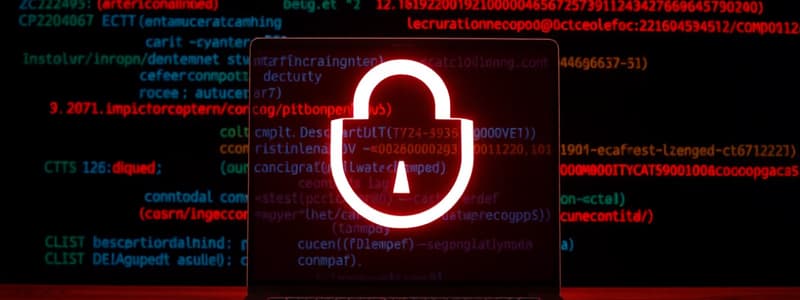Podcast
Questions and Answers
What are Indicators of Compromise (IoCs)?
What are Indicators of Compromise (IoCs)?
- Specific software developed to fix security vulnerabilities.
- Hardware devices that secure a network.
- Data protection measures against unauthorized access.
- Elements used to detect malicious activities. (correct)
What is a primary benefit of early detection of malicious activities?
What is a primary benefit of early detection of malicious activities?
- It allows for immediate user intervention.
- It prevents any future security incidents.
- It guarantees complete elimination of the threat.
- It minimizes potential damage and aids in incident response. (correct)
Which of the following is an indicator of a malware attack?
Which of the following is an indicator of a malware attack?
- Regular CPU usage patterns.
- Consistent software updates being applied.
- Increasing user logins during peak hours.
- New and unfamiliar files appearing. (correct)
What could serve as an indicator of a physical attack?
What could serve as an indicator of a physical attack?
In the context of network attacks, what does an abnormal traffic pattern indicate?
In the context of network attacks, what does an abnormal traffic pattern indicate?
What is a common indicator of an application attack?
What is a common indicator of an application attack?
What should be monitored as an indicator of cryptographic attacks?
What should be monitored as an indicator of cryptographic attacks?
Which of the following best represents an indicator of a password attack?
Which of the following best represents an indicator of a password attack?
Flashcards
Indicators of Compromise (IoCs)
Indicators of Compromise (IoCs)
Pieces of information that signal malicious activity, like unusual IP addresses, file changes, or data transfers.
Malware Attacks
Malware Attacks
Involve software designed to damage or infiltrate a system.
Physical Attacks
Physical Attacks
Unauthorized physical access to equipment.
Network Attacks
Network Attacks
Signup and view all the flashcards
Application Attacks
Application Attacks
Signup and view all the flashcards
Cryptographic Attacks
Cryptographic Attacks
Signup and view all the flashcards
Password Attacks
Password Attacks
Signup and view all the flashcards
Early Detection Importance
Early Detection Importance
Signup and view all the flashcards
Study Notes
Indicators of Compromise (IoCs)
- IoCs are pieces of information used to detect malicious activity.
- IoCs can include specific IP addresses, URLs, unusual file changes, or unauthorized data transfers.
- IoCs represent a wide range of observable events suggesting a security breach.
Importance of Early Detection
- Early detection of malicious activity allows for more effective containment and remediation.
- Minimizes potential damage and guides incident response.
- Familiarize yourself with common IoCs and regularly review logs and alerts to improve early detection.
Malware Attacks
- Malware attacks involve software designed to infiltrate or damage computer systems.
- Indicators may include unusual CPU usage, newly appearing files, or registry changes.
- Use reputable antivirus software and keep it up-to-date to detect and remediate malware threats.
Physical Attacks
- Unauthorized physical access to equipment is a type of attack.
- Indicators include surveillance footage of unfamiliar people near secure areas, or evidence of tampering.
- Regularly audit physical access logs and implement strong physical security measures.
Network Attacks
- Network attacks like DDoS or MITM (Man-in-the-Middle) show abnormal traffic patterns or unauthorized devices on the network.
- Regularly audit physical access logs and implement strong physical security measures.
Application Attacks
- Attacks target specific software, such as SQL injection or XSS.
- Indicators include failed login attempts or unexplained database changes.
- Regularly update applications and scan for vulnerabilities.
Cryptographic Attacks
- Attacks target encryption.
- Indicators include the unexpected appearance of plain-text versions of encrypted files or failed decryption.
- Keep cryptographic systems updated and follow best practices for key management.
Password Attacks
- Multiple failed login attempts or account lockouts are indicators of password attacks.
- Implement strong password policies and use multi-factor authentication.
Indicators (General)
- Common indicators across different attack vectors include unusual account activity, unexpected data flows, altered configurations, and new or unexpected software installations.
- Always keep an eye on logs and consider using an Intrusion Detection System (IDS) for real-time analysis.
Summary
- Recognizing IoCs is crucial for early detection and mitigation of threats.
- Each attack type has unique indicators.
- Familiarity with these indicators aids quick and effective response.
Review Questions (examples)
- What are some indicators of a physical attack?
- How can network monitoring tools aid in detecting malicious activity?
Key Points (General)
- Indicators of Compromise (IoCs) are crucial for early detection.
- Different attack types have unique indicators.
Practical Exercises (examples)
- Simulate basic network attacks in a controlled environment and use network monitoring tools to detect them.
- Review access logs from a test application to identify unusual patterns.
- Vigilant monitoring and a deep understanding of IoCs prepare you to respond to various cyber threats.
Studying That Suits You
Use AI to generate personalized quizzes and flashcards to suit your learning preferences.



